
This guest post by Rhea Daniel appears as part of our theme week on Fatphobia and Fat Positivity.
The thing with fat-haters is, that even a fat person, man or a woman, trying to stay healthy is offensive to them. Anybody who keeps bringing up your body out of the health concern, it’s just an excuse, they don’t really want to see you jiggling around. To quote Junot Díaz, “You think people hate a fat person? Try a fat person who’s trying to get thin.”
The presumption is that all fat people are unhealthy and lead a sedentary lifestyle, never mind that with all this fat-obsession in the medical field, the health of skinny kids gets ignored.
So let’s see what is perceived as “fat”: as with my case, anything above a US size 6 or 8 and you’ve crossed the point of no return. A size 2 would be perfect (but a size 0 would be too thin). Even the plus size industry is guilty of false advertising, fat models with the voluptuous, “proportionate” ideal are a crock. The fact is that the perception of the ideal female body has changed several times over hundreds of years, and here’s my beef: if this is true, and we know that the female body ideal is somehow connected to food availability and wealth, and that our bodies are some sort of sounding board off of which these subconscious perceptions are projected, different ones for different cultures and classes, then it’s time to stop falling for this illusion. And it’s time for women to stop doing it to each other.
So to The Heat.
Melissa McCarthy plays an ill-tempered, foul-mouthed detective and I like that she’s incorrigible just because; also, her entire godawful family is like that. Her primary concerns are the welfare of her brother and eventually of her cop-buddy, played by Sandra Bullock, so she is something of a protective mommy-bear. Her character may at first feed the stereotype that fat people are overbearing, belligerent and take up too much space, but the camera doesn’t make her body a joke (with accompanying thunder-thighs music). I like M.I.A.’s “Bad Girls” as the song of choice, and they do look pretty believably badass, with a comic overtone.
McCarthy’s character is literally a slob, and I see parts of this character in a lot of her movies—and yet it is her character who is comfortable with her body and sexuality, she couldn’t be bothered with romance (and no make-overs, thank goodness). The mantra in the media and the world in general is, that for a woman to have any substance, fat or otherwise, she has to be considered desirable, doesn’t matter by which demographic. If you really want to be inclusive (and I’m not talking Glee inclusivity—a fat person is either an object of pity or attractive to someone with a sudden, inexplicable fat-fetish), chuck desirability in the grinder. If you’re concerned about representing fat people, it’s time to dispense with the compensatory love interest, or some day someone will come along who loves you just the way you aaah…zzzz….. It’s patronising, and it’s tired storytelling.
Sandra Bullock’s character is a bit of a dweeb and its not the first time she’s played an FBI agent who has trouble winning the respect of her male colleagues. It is her character, of the more acceptable body-type, who feels the need to overcompensate, who wears Spanx and has trouble forming romantic relationships, or any relationship. Not exactly a subtle role reversal, but her reasons for being insecure seem pertinent as she grew up in foster care. Also, it’s not like even models who fit into an acceptable mold of beauty don’t feel insecure.
Now if you’re not used to seeing women in situations of slapstick violence, you might not like this movie. Consider those home videos where kids do ridiculous things and get their nuts hurt. Those are real people getting hurt. Slapstick comedy, on the other hand, is centuries old and a well-practiced art. The women in this movie express pain, stoically take it, and do their jobs. There’s a scene where they’re tied to chairs and McCarthy has to remove a knife lodged in Bullock’s thigh to cut their ropes and then shove it back in before they’re caught. I thought it was evil, comedic genius: Jackass for girls. No rubber super-maidens here. The kind of violence I dislike is eroticised violence and this is how to actually do it without insulting an entire gender.
Also see Jumpin’ Jack Flash, because I told you to.
So this is not a comedy a social critic would be comfortable with. How do you make an offensive comedy inoffensive toward minorities and without being obvious, actually turn the tables? Dan Bakkedahl who plays the albino DEA agent in the film specifically addresses the trope of the evil albino. While not completely off the hook, they tried and made some good decisions. I’m looking forward to a sequel where they might address any other issues.
And Melissa McCarthy…I’m sending you hearts and bouquets from this end of the world.
Rhea Daniel lives in Mumbai. She frequently finds herself in a bind between her love for art and her feminist conscience. She is trying to become a better writer and artist and you can find her at rheadaniel(dot)tumblr(dot)com.
















